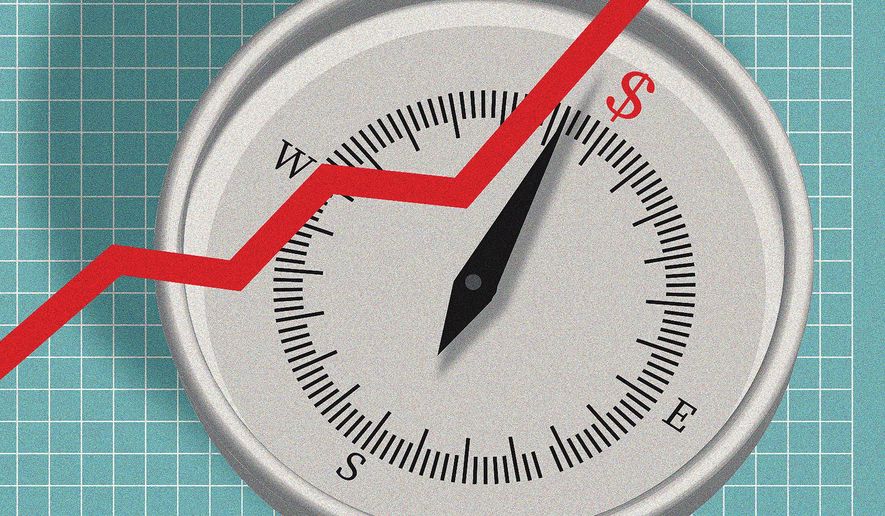OPINION:
These days an economist can’t cross the street without being asked if a recession is coming. The answer depends on how much inflation we are willing to tolerate.
On that front, the Federal Reserve has been getting good news lately.
December’s consumer price index report indicated that headline and core inflation — prices with the food and energy sectors removed — are moderating, and the economy continues to add jobs.
Unfortunately, inflation spreads through the economy unevenly. Focusing on progress and setbacks over a few months can be deceptive and seduce central bankers into poor judgment.
In the early months of 2021, overly generous stimulus checks and working from home inspired a shift in consumer demand from services to goods, and chip shortages and global transportation logjams pushed up inflation.
By May 2021, household expectations for inflation a year forward, as tracked by the Conference Board, New York Federal Reserve and University of Michigan, averaged about 5%. And the lines crossed in the labor market — the number of job openings began exceeding the number of Americans looking for work.
Federal Reserve Chairman Jerome Powell missed all this. The Fed hewed to notions that full employment was a long way off and printing money had little consequences for inflation. It didn’t address inflation by raising interest rates until March 2022.
Macroeconomists are enamored with the idea that observing financial markets can reveal the mysteries of the universe. They look to the differences between the interest rates paid on ordinary Treasury securities and inflation-indexed Treasuries to get a fix on where inflation is going.
Through 2021, the one-year spread never exceeded 2.7% — whereas in 2022, inflation turned out to be about 8% and closer to what surveys of consumers predicted.
We would have been better off had Mr. Powell and Treasury Secretary Janet Yellen fired their economists, been given a list of the 25 most frequently purchased goods and services at Trader Joe’s, Lowe’s and Orbitz, and gone shopping every month.
Going forward, several pressure points may still prove troublesome.
Gasoline prices have been falling because the Biden administration has drawn down the Strategic Petroleum Reserve. Demand in China has been depressed by an abrupt awakening from COVID-19, but that will reverse. And we have yet to see the full impact of Western sanctions on Russian oil exports.
We have good reason to believe that current gasoline prices are artificially depressed.
The demand for exported natural gas in Europe will grow, and that will push up U.S. heating and electricity costs.
Grain exports from Ukraine are not likely to increase, and climate change is wreaking havoc on farmers around the world.
Year-over-year U.S. farm prices were up 23% in November (latest data), and those will filter into grocery prices as we move through 2023.
The labor market remains tight. Workers jettisoned by tech giants such as Meta and Twitter are quickly finding new positions elsewhere in the tech sector and in the finance, health care and retail industries.
Job openings exceed job-seekers by about 70%. Small businesses continue to hire, and the labor market is nowhere close to balance.
Wages are rising about 6% a year, while productivity growth will likely remain pinned at about 1%. That’s inconsistent with 2% inflation.
The shift to green energy will push up the cost of electricity and automobiles. The grid is terribly overtaxed, and utilities lack good alternatives to natural gas when cold weather slows windmills and storms dampen solar generation.
From 2013 to 2021, the cost of lithium-ion battery packs fell by about 80%, but now that trend is reversing. Engineering improvements are getting tougher to accomplish, and tight material supplies abound.
Carmakers plan to unveil a host of new electric vehicles in the coming months, but those will be expensive. Chip shortages will continue, and car prices will fall only to the extent the economy slows, and people can’t afford to buy.
Rents on new apartment leases are falling because new household formation has dropped. That will put downward pressure on the housing component of the CPI later this year, especially as those affect imputed rent on owner-occupied dwellings. Rents, however, will rise as the economy strengthens in 2024 and more young people establish residences.
In his more recent ruminations, Mr. Powell has tried to convince financial markets that he’s not done fighting inflation, and they are not listening very well.
He would do well to keep his word, keep pushing up interest rates, even if more gradually, and then keep those elevated until inflation is at or below 2% for at least six months.
That would give us a recession. But harsh memories of the 1970s, when the Fed did not stay the course, suggest that a period of elevated unemployment is a price we must pay for profligate spending and money printing.
• Peter Morici is an economist and emeritus business professor at the University of Maryland, and a national columnist.




Please read our comment policy before commenting.